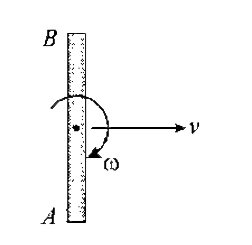Two equal uniform rods P and Q each of length l move with the same velocity v as shown in the figure. The second rod has an angular velocity ω(<6v/l and clockwise) about its centre of gravity g1 in addition to v.

If the ends A and A' are suddenly fixed simultaneously, both the rods will start to rotate with the same angular velocity
If the ends A and A' are suddenly fixed simultaneously, the rod Q will start to rotate with greater angular velocity
If the ends B and B' are suddenly fixed simultaneously, both rods will start to rotate with the same angular velocity
If the ends B and B' are suddenly fixed simultaneously, the rod P will start to rotate with greater angular velocity
The correct Answer is:B, D
Topper's Solved these Questions
- ROTATIONAL DYNAMICS BOOK - AAKASH SERIESCHAPTER - ROTATIONAL DYNAMICS EXERCISE - PRACTICE SHEET (Exercise - V) (LEVEL - II Matrix Matching type Questions)
4 Videos
- ROTATIONAL DYNAMICS BOOK - AAKASH SERIESCHAPTER - ROTATIONAL DYNAMICS EXERCISE - PRACTICE SHEET (Exercise - VI) (LEVEL - I Straight Objective Type Questions)
5 Videos
- ROTATIONAL DYNAMICS BOOK - AAKASH SERIESCHAPTER - ROTATIONAL DYNAMICS EXERCISE - PRACTICE SHEET (Exercise - IV) (LEVEL - II Integer Type Questions)
6 Videos
- RIVISION EXERCISEBOOK - AAKASH SERIESCHAPTER - RIVISION EXERCISEEXERCISE - MOTION IN A PLANE (LAMNI.S THEOREM)
6 Videos
- ROTATIONAL MECHANICSBOOK - AAKASH SERIESCHAPTER - ROTATIONAL MECHANICSEXERCISE - Questions for Descriptive Answers
20 Videos
Similar Questions
A small conducting rod of length l, moves with a uniform velocity v in a uniform magnetic field B as shown in fig __

View SolutionFind the instantneous axis of rotation of a rod length l when its end A moves with a velocity →vA=ˆi and the rod rotates with an angular velocity →ω=−v2lˆk.

View Solution
Knowledge Check
Two equal uniform rods P and Q move with the same velocity v as shown in the figure. The second rod has an angular velocity ω(<6v/l) (clockwise) about G in addition to v.
 AIf the ends A and A' are suddenly fixed simultaneously both rods will rotate with the same angular velocityBIf the ends A and A' are suddenly fixed simultaneously the rod Q will rotate with greater angular velocityCIf the ends B and B' are suddenly fixed simultaneously both rods will rotate with the same angular velocityDIf the ends B and B' are suddenly fixed simultaneously, the rod P will rotate with greater angular velocity
AIf the ends A and A' are suddenly fixed simultaneously both rods will rotate with the same angular velocityBIf the ends A and A' are suddenly fixed simultaneously the rod Q will rotate with greater angular velocityCIf the ends B and B' are suddenly fixed simultaneously both rods will rotate with the same angular velocityDIf the ends B and B' are suddenly fixed simultaneously, the rod P will rotate with greater angular velocityA rod AB moves with a uniform velocity v in a uniform magnetic field as shown in figure.
 AThe rod becomes electrically chargedBThe end A becomes positively chargedCThe end B becomes positively chargedDThe rod becomes hot because of Joule heating
AThe rod becomes electrically chargedBThe end A becomes positively chargedCThe end B becomes positively chargedDThe rod becomes hot because of Joule heatingA small conducting rod of length l, moves with a uniform velocity v in a uniform magnetic field B as shown in fig __
 AThen the end X of the rod becomes positively chargedBThe end Y of the rod becomes positively chargedCThe entire rod is unevenly chargedDThe rod becomes hot due to joule heating
AThen the end X of the rod becomes positively chargedBThe end Y of the rod becomes positively chargedCThe entire rod is unevenly chargedDThe rod becomes hot due to joule heating
Find the instantneous axis of rotation of a rod length l when its end A moves with a velocity →vA=Vi and the rod rotates with an angular velocity →ω=−v2lˆk.

View SolutionA rod AB moves with a uniform velocity v in a uniform magnetic field as shown in figure

View SolutionIf the rod were translating as well as rotating, what will be its emf? Assume that the centre of mass has a velocity v and the rod is rotating with an angular velocity ω atout its centre of mass.
View SolutionIf the rod were translating as well as rotating, what will be its emf? Assume that the centre of mass has a velocity v and the rod is rotating with an angular velocity ω atout its centre of mass.
View SolutionA uniform rod AB of length l rotating with an angular velocity ω while its centre moves with a linear velocity v=ωl6 If the end A of the rod is suddenly fixed, the angular velocity of

View Solution
